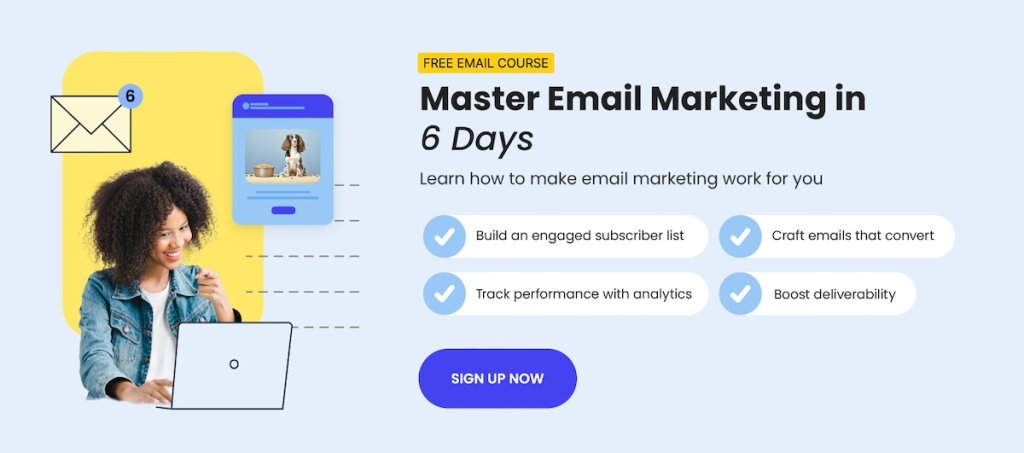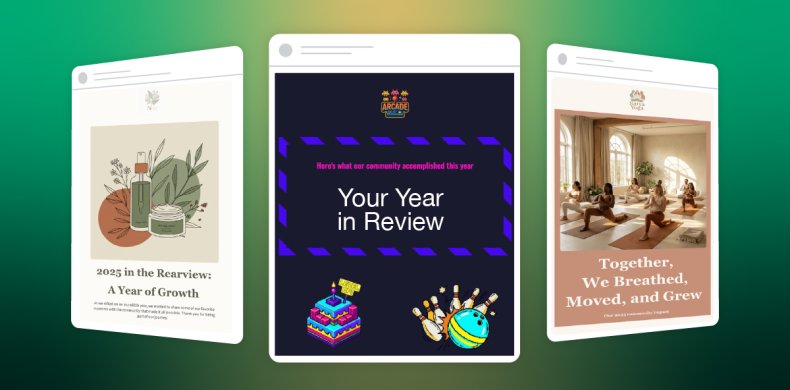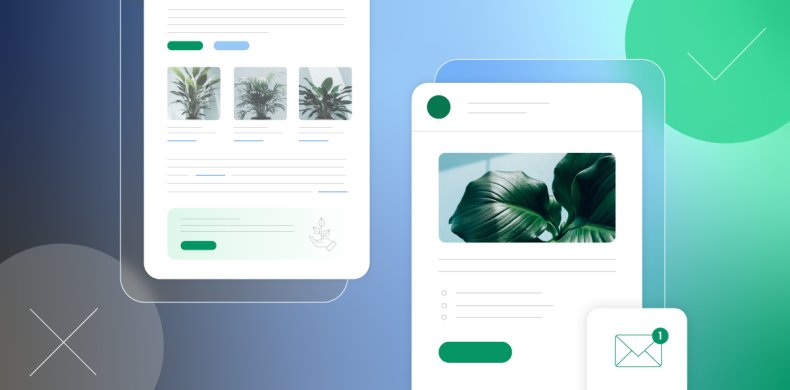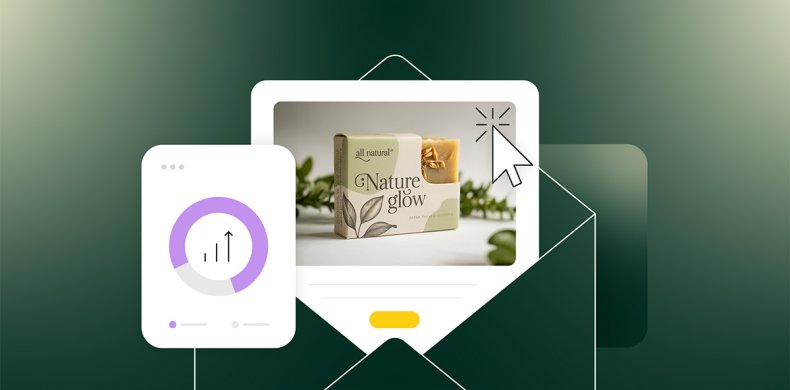How to Write Effective Email CTAs (+ Examples)

This article was originally published in April 2025, and then updated in July 2025.
You’ve nailed the subject line, curated engaging content, and designed an eye-catching template—everything seems perfectly aligned for success. Yet there’s one can’t-live-without element that can make or break your email marketing campaign—your call to action, or CTA. This small yet powerful piece of text serves as the link between your message and the recipient’s next move.
However, making it work takes more than just slapping a CTA button on your email and hoping for the best. From picking the perfect words and choosing the right colors to finding that sweet spot for placement, every detail matters.
Fear not—we’ve got your back! With these tried-and-true tips and powerful call to action examples, you’ll be all set to create effective CTAs that encourage subscribers to take action and drive results in your email marketing campaigns.
Why Does a Good Call to Action Matter?
As a small business owner or someone working independently, you likely don’t send email marketing campaigns just for the sake of it—you create them with a specific goal.
Building your email list is all about converting subscribers into customers, but without a clear CTA, your audience may hesitate instead of taking action. A well-placed email CTA guides them through the customer journey so that they move forward efficiently and effectively.
However, not every email needs to be, nor should it be, a sales pitch. Sometimes, your emails are just meant to share valuable insights and foster trust. Think newsletters or lead nurturing emails—here, the focus might be more on informing and entertaining rather than pushing for an immediate action. In these cases, an email call to action can be as subtle as a gentle nudge, inviting readers to dive deeper into your content or engage at their own pace.
So, whether you’re driving conversions or building relationships, the strategic use of calls to action will ensure your emails resonate with your target audience and support the growth of your business or project.

Best Practices for Email Calls to Action
Now that we’ve got the basics down, let’s unpack all that goes into an effective email CTA—from copy and design to the destination URL—and discover how to crank up those click-through rates.
1. Write Short and Magnetic Copy
Whether you’re leveraging action words, highlighting benefits, or creating a sense of urgency, persuasive language compels recipients to take the desired action. It reinforces the value proposition you’ve crafted within the content of your email and, ideally—your subject line too.
While opting for a hyperlink within action-oriented text gives you the freedom to play with your phrasing, when it comes to your call-to-action button, brevity is your best friend. Aim for a concise copy, ideally two to four words long, as anything longer might lose its charm. It could also be a tight squeeze on mobile screens, which, in case you didn’t know, are the go-to choice for checking emails.
2. Speak in First-Person
Calls to action can work their magic without directly addressing the reader, but why not add a dash of first-person charm? By incorporating pronouns like “I,” “me,” “my,” and “mine,” you can transform your email CTA into a personal invitation that taps into the reader’s self-interest. It’s like whispering, “This is just for you!”
Suppose you’re running an email campaign for a special promotion. Instead of using the phrase “Get 10% Off” in your email CTA you might say “Claim My 10% Discount.” This subtle shift can enhance the overall message, making readers feel like active participants in their journey with your brand.
3. Use Approachable Action Words
As we already mentioned, for a call to action to be effective, it should include action-oriented language that guides the reader to achieve the desired outcome. However, some verbs like “submit,” “register,” “buy,” and “download,” can make your readers feel uneasy, as they imply a greater commitment—whether it’s spending money, investing time, or making a firm decision they might not be ready for.
To counteract this, it’s important to provide readers with a sense of choice. You can do that by replacing the verbs above with more approachable ones like “Get,” “Start,” “Explore,” or “Try.” These words feel less committal and more inviting, encouraging further engagement without pressure.

4. Be Mindful of Colors and Font Sizes
When choosing colors for your call to action, whether for text or buttons, aim to create a contrast with the background to prevent blending with other design elements in your email. A tool like the WebAIM Contrast Checker can help you nail the perfect contrast ratio. For optimal readability, it’s best to use a font size between 16-20 pixels.
Additionally, when crafting a CTA button, give it some breathing room with ample spacing (whitespace). This way, you ensure it pops out, making it a breeze for users to tap the right link and dodge any mix-ups!
The email CTA button below is a good example of making the CTA button really pop.

5. Design for Mobile
While clicking a link with a mouse on a desktop offers precise control, tapping a call to action on a mobile device can be more challenging, especially if it’s a button. Therefore, when including a CTA button, aim for a height between 35 and 45 pixels to make sure it’s easy for the reader to interact with it.
For enhanced accessibility, consider increasing the height of your CTA buttons to 50 pixels to make them easier for individuals with visual impairments to identify. Furthermore, setting the width in percentages, rather than fixed pixels, allows your CTA buttons to automatically adjust to various screen sizes, ensuring they display correctly on any device.
SiteGround Email Marketing makes it easy to create mobile-friendly emails that look great on any device. From responsive buttons and images to perfectly scaled text, everything is optimized for the small screen. Plus, you get predesigned templates, smart segmentation, automation features, and an AI-powered email writer to help you hit send faster.
6. Mind the Number
A common question among marketers is, “How many CTAs in an email are too many?” Some argue that including many CTAs provides subscribers with various options to engage, potentially increasing interest. However, too many email CTAs can overwhelm readers, dilute your message, and even harm your sender reputation by making your email appear spammy.
To strike the right balance, aim for no more than one link per 125 words of text, which helps maintain a balanced link-to-text ratio and prevents your email from being overloaded with links. If your email includes more images, a good rule of thumb is to limit your hyperlinks to a maximum of three.
Types of Email CTAs
As you decide how many CTAs to include, it’s also important to consider the type of CTA you’re using. Marketing teams typically identify two main types:
- Primary CTA: This is the main action you want the recipient to take—such as making a purchase, signing up, or visiting a webpage. It aligns with your email’s core purpose and should stand out visually with bold colors, large fonts, or a prominent button. You might include it in more than one place within the email, but it still counts as a single action in terms of importance.
- Secondary CTA: A secondary CTA provides an alternative path for readers who aren’t ready to act on the primary ask. This might include following your brand on social media or exploring related content. These are usually more subtle—styled as hyperlinks or understated buttons—and placed further down the email.
By combining a clear primary email call to action with an optional secondary one—and keeping the total number of links in check—you can guide readers effectively without overwhelming them.
7. Optimize The Placement
To maximize the visibility of your calls to action, strategic placement is key—it’s the difference between an email marketing campaign that succeeds and one that falters.
If your primary CTA is tucked away at the bottom of a long email without any context, users might not scroll far enough to find it. So, give your CTA the spotlight it deserves by placing it near the top, or “above the fold,” right after those enticing product features or benefits. This way, it grabs attention right from the start and encourages immediate action.

With the rise of AI email summaries, this placement becomes even more important, as these summaries can push content further below the fold. Therefore, it’s important to ensure that your most important messages, including a key CTA, are positioned closer to the top.
Also, don’t forget those curious clickers who love to explore every aspect of your email, from the logo to headlines and images. By embedding the same link in these elements, you can subtly direct readers to your desired destination, often without them even realizing it.
8. Do The Blurriness Test
While we highly recommend A/B testing to evaluate your email call to action performance, there’s a quick visual test you can use called the “blurriness test.”
To conduct this test, convert your email into an image and apply a high level of blur (around 50%). Then, take a step back and examine the blurred image. This technique helps you assess whether the layout is well-organized and if the primary call to action stands out and remains prominent, even when details are obscured. If your CTA is still noticeable, it suggests that it will catch the reader’s eye in a real-world scenario.
Below is a call-to-action example of an email that passes the blurriness test. Can you tell where the CTA buttons are placed?

You probably guessed it: you can find one at the top of the email and another at the end.
9. Include UTM Tags Within the Destination Link
You’ve completed the previous nine steps, added the destination link to the call to action, and now, you might be tempted to wrap things up and send this email. But wait!
Imagine you’re promoting a landing page on your website and want to use the same link across other digital marketing channels, such as social media posts and online ads, not just email marketing campaigns. How can you determine which channel is generating the most traffic and engagement for your landing page?
This is where UTM parameters come into play—these are tags you can append to your URLs to track the source, medium, and campaign name in your analytics tool. By using UTM parameters, you can gain detailed insights into the performance of each marketing channel, allowing you to make data-driven decisions to optimize your marketing strategy and allocate resources more efficiently.
You can easily create UTM parameters using free tools like the Google Campaign URL Builder, and monitor their performance in Google Analytics.
Email Call-to-Action Examples
We know there are many tools to help you come up with CTAs for your emails, including AI—everyone’s best friend. So, rather than overwhelming you with a long list of CTA copy you’ve likely seen before, we’re providing you with real-life examples to spark your creativity. Use these to experiment and try something new when designing your next email campaign.
Jump In
This welcome email from Vimeo is a perfect example of how including multiple calls to action can effectively encourage newcomers to explore your services. Right from the start, the email invites readers to “jump in” with a prominent primary CTA button, while additional calls to action are strategically placed throughout the copy to subtly introduce other features and functionalities they benefit from.

Give Us Feedback
survey email below, Food52 playfully asks readers to give them some “food for thought,” extending this clever wordplay into their CTA copy. Did you catch that? While “give us feedback” is straightforward, it also cheekily hints at giving “feed” back, suggesting a return of something nourishing to the sender. It’s a subtle touch, but definitely an effective one!

Get Lucky
Simpler Hair Color used a creative approach to guide readers toward the desired action: leveraging the gaze within an image. This subtle yet powerful visual cue naturally draws the reader’s attention, increasing the likelihood of engagement with the email CTA button below the image.

Additionally, by strategically placing elements like lines, arrows, or a play button on images, you can direct the reader’s eye along a clear path. These techniques not only enhance the visual appeal of your messages but also increase email marketing campaign effectiveness by focusing attention on key actions.
Complete Your Look
For Adidas, the CTAs are subtly placed by using clickable images instead of multiple CTA buttons. This strategy encourages customers to explore and effectively boosts conversion rates by directing them to curated product pages. It provides a seamless shopping experience, allowing customers to easily explore and purchase featured items directly from the promotional email—genius, isn’t it?

Feel the Difference
In their product launch email, TheraOne invites customers to dive into their latest offerings. The email highlights the unique benefits and features of these new products, aiming to capture the interest of potential buyers. To top it off, a vibrant email CTA button beckons with the phrase “Feel the Difference,” encouraging recipients to click and experience the hype firsthand. It does make you curious, doesn’t it?

Transform Your Email CTA Knowledge into Results
A compelling call to action is more than just a few action words placed randomly in your email—it’s the driving force that transforms interest into engagement and curiosity into conversion. By applying expert tips and techniques, you can enhance the visual appeal and effectiveness of your email campaigns, seamlessly guiding your readers toward the action you want them to take.
With SiteGround Email Marketing, effective CTA creation is built right in. You get pre-designed button styles that are easy to customize: adjust shape, color, and outline with just a few clicks. Plus, every hyperlink you add is automatically styled for visibility—colored by default and underlined on hover—so they’re easy to spot and even easier to click. So, are you ready to put your CTAs to work?
This article was originally published in April 2025, and then updated in July 2025.




Comments ( 0 )
Thanks! Your comment will be held for moderation and will be shortly published, if it is related to this blog article. Comments for support inquiries or issues will not be published, if you have such please report it through our official channels of communication.
Leave a comment
Thanks! Your comment will be held for moderation and will be shortly published, if it is related to this blog article. Comments for support inquiries or issues will not be published, if you have such please report it through our official channels of communication.